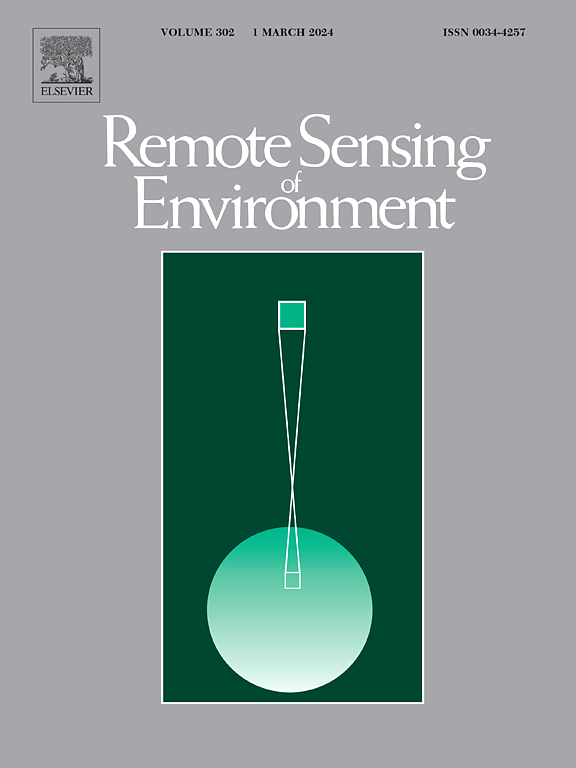Enhancing terrestrial net primary productivity estimation with EXP-CASA: A novel light use efficiency model approach
IF 11.1
1区 地球科学
Q1 ENVIRONMENTAL SCIENCES
引用次数: 0
Abstract
The Light Use Efficiency (LUE) model, epitomized by the Carnegie-Ames-Stanford Approach (CASA) model, is extensively applied in the quantitative estimation and analysis of vegetation Net Primary Productivity (NPP). However, the classic CASA model is marked by significant complexity: the estimation of environmental stress, in particular, necessitates multi-source observation data and model parameters, adding to the complexity and uncertainty of the model’s operation. Additionally, the saturation effect of the Normalized Difference Vegetation Index (NDVI), a key variable in the CASA model, weakens the accuracy of CASA’s NPP predictions in densely vegetated areas. To address these limitations, this study introduces the Exponential-CASA (EXP-CASA) model. The EXP-CASA model effectively improves the CASA model with RMSE decreasing by 37.5% by using novel functions for estimating the fraction of absorbed photosynthetically active radiation (FPAR) and environmental stress, utilizing long-term observational data from FLUXNET and MODIS surface reflectance data. In a comparative analysis of NPP estimation accuracy, EXP-CASA (, ) performs better than the NPP product from GLASS (, ). Additionally, this research assesses the EXP-CASA model’s adaptability to various vegetation indices, evaluates the sensitivity and stability of its parameters over time, and compares its accuracy against other leading NPP estimation products across different seasons, latitudinal zones, ecological types, and temporal sequences. The findings reveal that the EXP-CASA model exhibits strong adaptability to diverse vegetation indices and stability of model parameters over time series. Importantly, EXP-CASA displays superior sensitivity to NPP anomalies at flux sites and more accurately simulates short-term NPP fluctuations than GLASS-NPP and captures periodic trends. By introducing a novel estimation approach that optimizes model construction, the EXP-CASA model remarkably improves the accuracy of NPP estimations, paving the way for global-scale, consistent, and continuous assessment of vegetation NPP. It presents an effective approach for evaluating the saturation effect of vegetation indices and the influence of category independence on NPP estimation.
基于EXP-CASA的陆地净初级生产力估算:一种新的光能利用效率模型方法
以卡耐基-艾姆斯-斯坦福方法(CASA)为代表的光利用效率(LUE)模型被广泛应用于植被净初级生产力(NPP)的定量估算和分析。然而,经典CASA模型具有显著的复杂性,特别是环境应力估计需要多源观测数据和模型参数,增加了模型运行的复杂性和不确定性。此外,CASA模型中关键变量归一化植被指数(NDVI)的饱和效应削弱了CASA在植被密集地区NPP预测的准确性。为了解决这些局限性,本研究引入了指数casa (EXP-CASA)模型。EXP-CASA模型利用FLUXNET的长期观测数据和MODIS的地表反射率数据,引入了估算吸收光合有效辐射(FPAR)和环境应力的新函数,有效地改进了CASA模型,RMSE降低了37.5%。在NPP估算精度对比分析中,EXP-CASA (R2=0.68, RMSE=1.1gC·m−2·d−1)优于GLASS (R2=0.61, RMSE=1.2gC·m−2·d−1)。此外,本研究还评估了EXP-CASA模型对各种植被指数的适应性,评价了其参数随时间变化的敏感性和稳定性,并在不同季节、纬度带、生态类型和时间序列上与其他主要NPP估算产品进行了精度比较。结果表明,EXP-CASA模型对多种植被指数具有较强的适应性,模型参数具有较好的时间序列稳定性。重要的是,EXP-CASA对通量站点的NPP异常具有优越的敏感性,并且比GLASS-NPP更准确地模拟短期NPP波动并捕获周期性趋势。EXP-CASA模型通过引入一种优化模型构建的估算方法,显著提高了NPP估算的精度,为实现植被NPP的全球尺度、一致性和连续性评估铺平了道路。为评价植被指数的饱和效应和类别独立性对NPP估算的影响提供了一种有效的方法。
本文章由计算机程序翻译,如有差异,请以英文原文为准。
求助全文
约1分钟内获得全文
求助全文
来源期刊

Remote Sensing of Environment
环境科学-成像科学与照相技术
CiteScore
25.10
自引率
8.90%
发文量
455
审稿时长
53 days
期刊介绍:
Remote Sensing of Environment (RSE) serves the Earth observation community by disseminating results on the theory, science, applications, and technology that contribute to advancing the field of remote sensing. With a thoroughly interdisciplinary approach, RSE encompasses terrestrial, oceanic, and atmospheric sensing.
The journal emphasizes biophysical and quantitative approaches to remote sensing at local to global scales, covering a diverse range of applications and techniques.
RSE serves as a vital platform for the exchange of knowledge and advancements in the dynamic field of remote sensing.
 求助内容:
求助内容: 应助结果提醒方式:
应助结果提醒方式:


